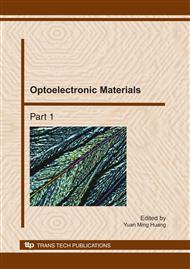[1]
W. Y. Jia, H. B. Yuan, L. Z. Lu et al.: J. Cryst. Growth. Vol. 200 (1999), p.179.
Google Scholar
[2]
J. Holsa, H. Jungner et al.: J. Alloys Compd. Vol. 323–324 (2001), p.326–330.
Google Scholar
[3]
Y. L. Chang, H. I. Hsiang and M. T. Liang: J. Alloys Compd. Vol. 461 (2008), p.598.
Google Scholar
[4]
A. Nag and T. R. N. Kutty: J. Alloys Compd. Vol. 354 (2003), p.221–231.
Google Scholar
[5]
M. Y. Peng, Z. W. Pei and G. G. Hong: Chem. Phys. Lett. Vol. 371 (2003), p.894.
Google Scholar
[6]
Y. T. Guo and Y. M. Huang: Key Engineering Materials. Vol. 428-429 (2010), pp.421-425.
Google Scholar
[7]
Y. T. Guo and Y. M. Huang: Key Engineering Materials. Vol. 428-429 (2010), pp.544-547.
Google Scholar
[8]
T. Matsuzawa, Y. Aoki et al.: J. Electrochem. Soc. Vol. 143 (1996), p.2670.
Google Scholar
[9]
A. Diaz and D. A. Keszler: Mater. Res. Bull. Vol. 31 (1996), p.147.
Google Scholar
[10]
E. Broussell, L. Fortina, S. Kulyuk et al.: J. Appl. Phys. Vol. 84 (1998), p.531.
Google Scholar
[11]
H. Takasaki, S. Tanabe and T. Hanada: J. Ceram. Soc. Jpn. Vol. 104 (1996).
Google Scholar
[1]
(If square brackets are not available, slashes may be used instead, e. g. /2/. ) Two or more references at a time may be put in one set of brackets [3, 4]. The references are to be numbered in the order in which they are cited in the text and are to be listed at the end of the contribution under a heading References, see our example below. Summary On your CD, please indicate the format and word processor used. Please also provide your phone number, fax number and e-mail address for rapid communication with the publisher. Please always send your CD along with a hard copy that must match the CD's content exactly. If you follow the foregoing, your paper will conform to the requirements of the publisher and facilitate a problem-free publication process. References.
Google Scholar
[1]
Dj.M. Maric, P.F. Meier and S.K. Estreicher: Mater. Sci. Forum Vol. 83-87 (1992), p.119.
Google Scholar
[2]
M.A. Green: High Efficiency Silicon Solar Cells (Trans Tech Publications, Switzerland 1987).
Google Scholar
[3]
Y. Mishing, in: Diffusion Processes in Advanced Technological Materials, edtied by D. Gupta Noyes Publications/William Andrew Publising, Norwich, NY (2004), in press.
Google Scholar
[4]
G. Henkelman, G. Johannesson and H. Jónsson, in: Theoretical Methods in Condencsed Phase Chemistry, edited by S.D. Schwartz, volume 5 of Progress in Theoretical Chemistry and Physics, chapter, 10, Kluwer Academic Publishers (2000).
Google Scholar
[5]
R.J. Ong, J.T. Dawley and P.G. Clem: submitted to Journal of Materials Research (2003).
Google Scholar
[6]
P.G. Clem, M. Rodriguez, J.A. Voigt and C.S. Ashley, U.S. Patent 6, 231, 666. (2001).
Google Scholar
[7]
Information on http: /www. weld. labs. gov. cn.
Google Scholar


